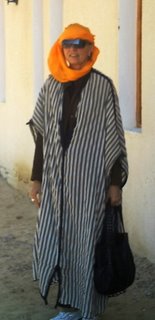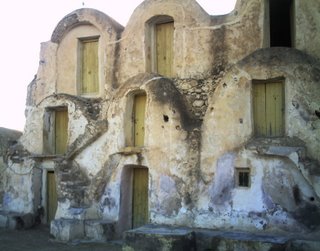May the Force be with You
 Houmt Souk
Houmt SoukAlong the way to Houmt Souk, I was astonished at the birds visible along the shoreline: flamingos, herons, gulls, and others. The covered market area had numerous shops selling many of the same products–a lot of hastily decorated, hand-painted pottery. The central market, however, was more authentic. There, in stalls in a warehouse-type structure, vendors were selling fresh vegetables: stacks of vividly orange carrots, apples, greens, spices, dates, and other foodstuffs. A basketball-size, reddish-yellow squash half stood up right, with tiny insects swarming over it. Another building sold meat products. Chunks of beef (hooves too) for steaks, roast, or flanks for stew lay out in the open on wood counters. The cows head displayed whole on the wall beside one stand advertised its fare. The fish auction was fascinating. An auctioneer in a red felt hat, standing behind a booth filled fresh with the days catch, holds up a string of fish. Men in front place their bids; and the fishes go to the highest bidder.
Many of the over-30 generation dress in traditional clothing. Women wear off-white jellabahs or material trimmed with red, green, and gold embroidered trim. I did see one woman covered in multi-colored polka dotted material. Maybe the fabric was on sale. Obviously, she wasn’t going to see someone else wearing her dress in public. Men wear gray jellabahs or slacks and shirt with the round gray or red felt hat. A common winter costume is the brown burnoose with hood, trimmed with black embroidery. Conservative western dress is also common for men.
 The pace of life seems slower here. Tourists mingle through the bazaars, many fewer than during the high summer season; but don’t seem to attract undue attention. The high temperatures of summer are past. An occasional cloudy day makes for comfortable strolling. Merchants with tourist wares to sell live up to their usual reputation. Taxi drivers and travel agencies may try to make an extra dinar or two. Yet, the city’s structures aren’t over two to three stories, built in pseudo-Djerbian mode; and the city itself is small. Traffic is manageable. People will take time to answer a question; a characteristic mostly lost in the commotion of Tunis. I feel space, so far only that achieved from looking at bogs of marshy shoreline (visited by creatures of the feathery kind), out to the Gulf of Gabes with nothing but waves on the horizon, or at semi-arid land extending from the densely built up hotel district to Houmt Souk. The top of the 15th century Arab fort provides a valued view of the white city and the small fishing boats in the bay. I sense a more human scale. Although I suppose you could develop island fever, if you stayed here long enough.
The pace of life seems slower here. Tourists mingle through the bazaars, many fewer than during the high summer season; but don’t seem to attract undue attention. The high temperatures of summer are past. An occasional cloudy day makes for comfortable strolling. Merchants with tourist wares to sell live up to their usual reputation. Taxi drivers and travel agencies may try to make an extra dinar or two. Yet, the city’s structures aren’t over two to three stories, built in pseudo-Djerbian mode; and the city itself is small. Traffic is manageable. People will take time to answer a question; a characteristic mostly lost in the commotion of Tunis. I feel space, so far only that achieved from looking at bogs of marshy shoreline (visited by creatures of the feathery kind), out to the Gulf of Gabes with nothing but waves on the horizon, or at semi-arid land extending from the densely built up hotel district to Houmt Souk. The top of the 15th century Arab fort provides a valued view of the white city and the small fishing boats in the bay. I sense a more human scale. Although I suppose you could develop island fever, if you stayed here long enough. The Mediterranean is remarkable this time of year. One day it can be placating and soothing, with waves regularly rolling in under a clear sky. Another day can start out serenely; but then a squall blows in. Clouds appear; the wind picks up blowing the curtains through the windows and threatening to overturn outdoor umbrellas on the beach and sundecks. The waves approach with greater force, speed, and higher crests. I love it. It’s not threatening only energizing. Nature seems stirred with a sense of power and creativity, as if it wants to attract your attention. The sky grows varied with ever changing rain clouds (a photographer’s delight), the water forms new colors–cobalt blue farther out, patches of it in other places, cerulean blue closer in. All continually in movement. The rain that comes in big drops refreshes but doesn’t last long.
 Matmata
MatmataOnto the ferry again, to cross over from Djerba to the continent to visit Matmata. In the fishing port of Ajim, I saw a live fish auction and the amphorae used to entrap squid. Lines strung through the pots lower them into the sea. Squid, prizing their protective value, make them their nighttime dwellings. Fishermen then raise the pots in the early morning hours before the squid awaken; and make a good harvest during the months of December and January. Matmata is the best-known troglodyte village in Tunisia. Berbers used these dwellings carved into the sides of an earthen basin for their isothermal qualities. They maintain a relatively constant temperature all year round. Their underground location in a landscape of uneven barren hills gives the terrain a science fiction aspect. These aspects were so appealing that several of the Star Wars movies were filmed here. The village was constructed in the ground and at one time probably moved in harmony with the rhythm of the sun and nature itself. With one furnished room, the area is more of a place to visit than one of present-day habitation. The fascinating part is the entry through a tunnel extended from an exterior cave into the crater-like central cavity itself. A Berber woman gives a demonstration of meal grinding.
Douz
Called the door to the Sahel, Douz today is an entirely new city, which supports itself through date harvesting from the nearby Palmeries and the tourist trade. The old city is covered by sand. Modern-day Tuaergs dress in black and white striped jellabahs (robes), with brightly colored (orange, blue, or red) headscarves to identify their group, rather than the customary indigo blue, and then have their choice of visiting the dunes on camel or in horse-drawn cart. I was tempted to wax cynical; but then realized that Tunisia has few options in terms of economic development, especially in the southern portion of the country. Tunisia has few natural resources and no oil, unlike neighboring Algeria. It has date palms, olive trees, and a prospective free-exchange zone on the horizon. Most of the country’s infrastructure benefits the northern coastal area. The South remains divided between poverty and abundance, depending on the presence or absence of the tourist industry. Tourism remains overall the foremost Tunisian business; it empowers the rest of the economy. With Tunisia less dependent on American tourists than Morocco, the events of September 11, 2001, registered little impact on tourism.
 Medenine
MedenineHere I saw one of the ksours (fortified villages) the region is known for. Constructed by Berbers of dried mud and brick, a ksar consists of several stories and chambers with arched entrances. The cells (ghorfas) preserved grain even for years, due to the low humidity of the region. Such constructions unfortunately, deteriorate quickly under the influence of wind and the rare but torrential rains which impact the area. The roadside ksar I saw has served as a hotel –0 star to be sure. However, the price is low, washing facilities are available on the first floor. If one wishes to entertain a Berber lifestyle à la imagination, a stay in an ancient ksar, later turned fortification, could be a beginning.
Return to Djerba
I returned to the island on the bridge, which follows a Roman road between the mainland and the current village of El Kantara. Now, Djerba gets its water from the continent; and water pipelines follow the roadway above ground. Humility and a sense of paradox are what I felt as I called an end to the day. Crossing a passageway used for thousands of years to I returned to the tourist zone with its stretch of innovative, as well as homogeneous hotels, replete all the most up-to-date amenities–where a sense of the past is found in only an occasional decorative façade on a newly built panel.


0 Comments:
Post a Comment
<< Home